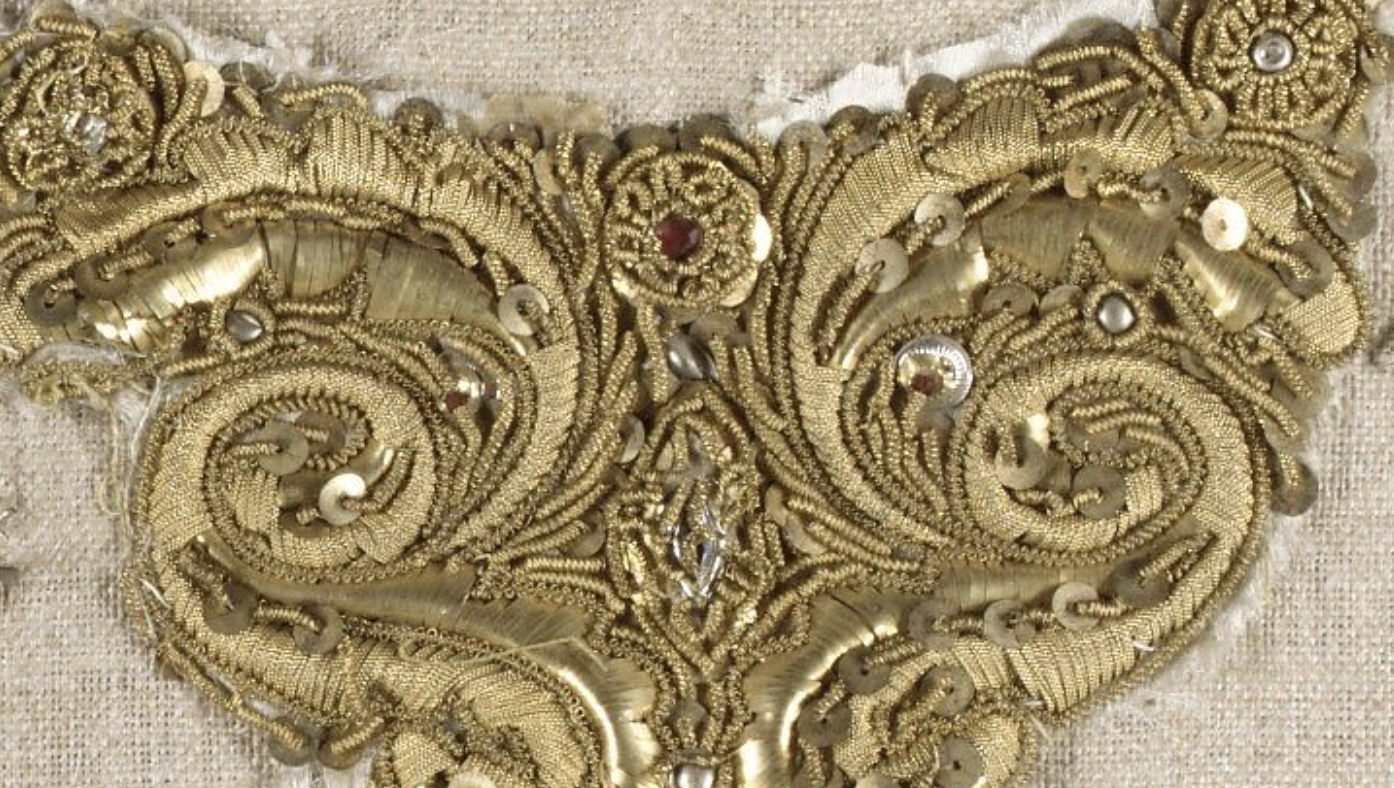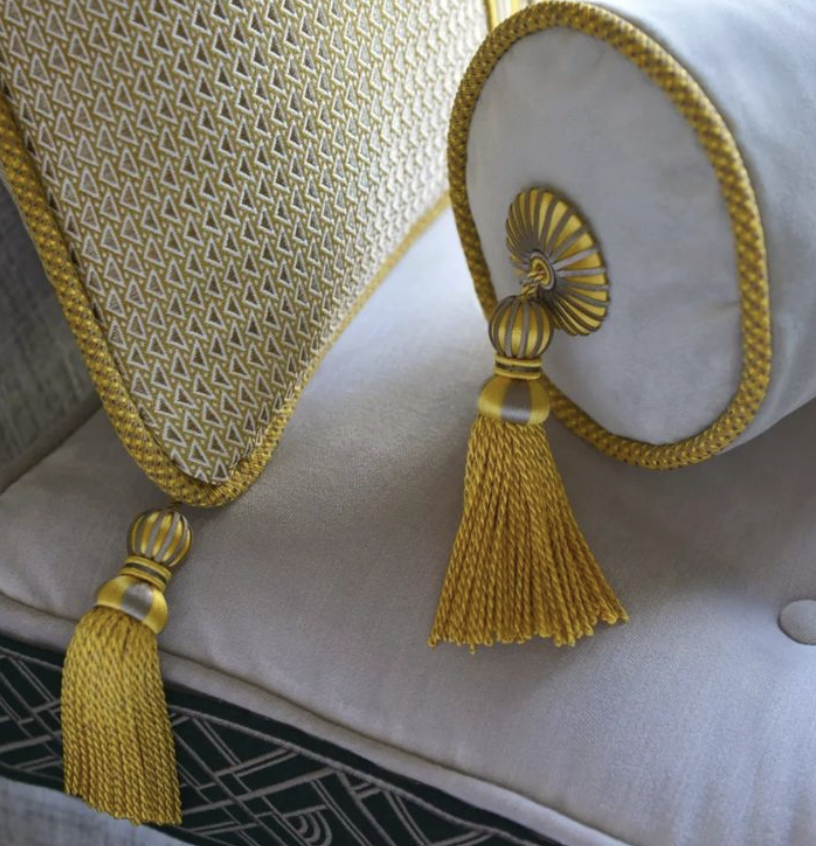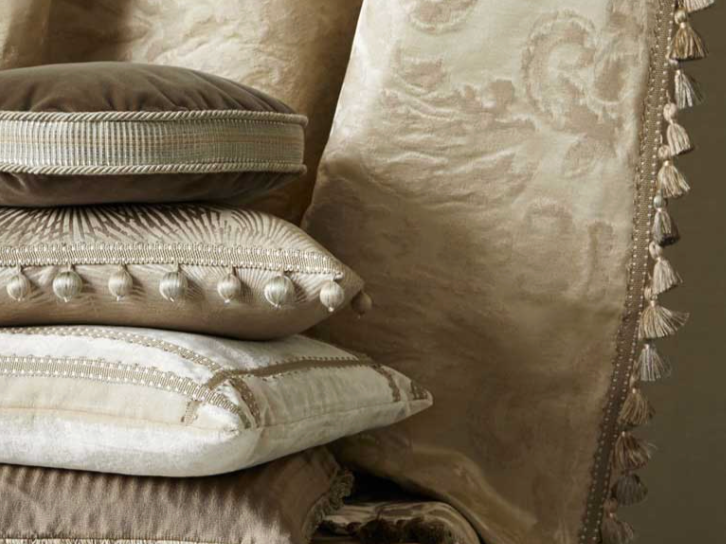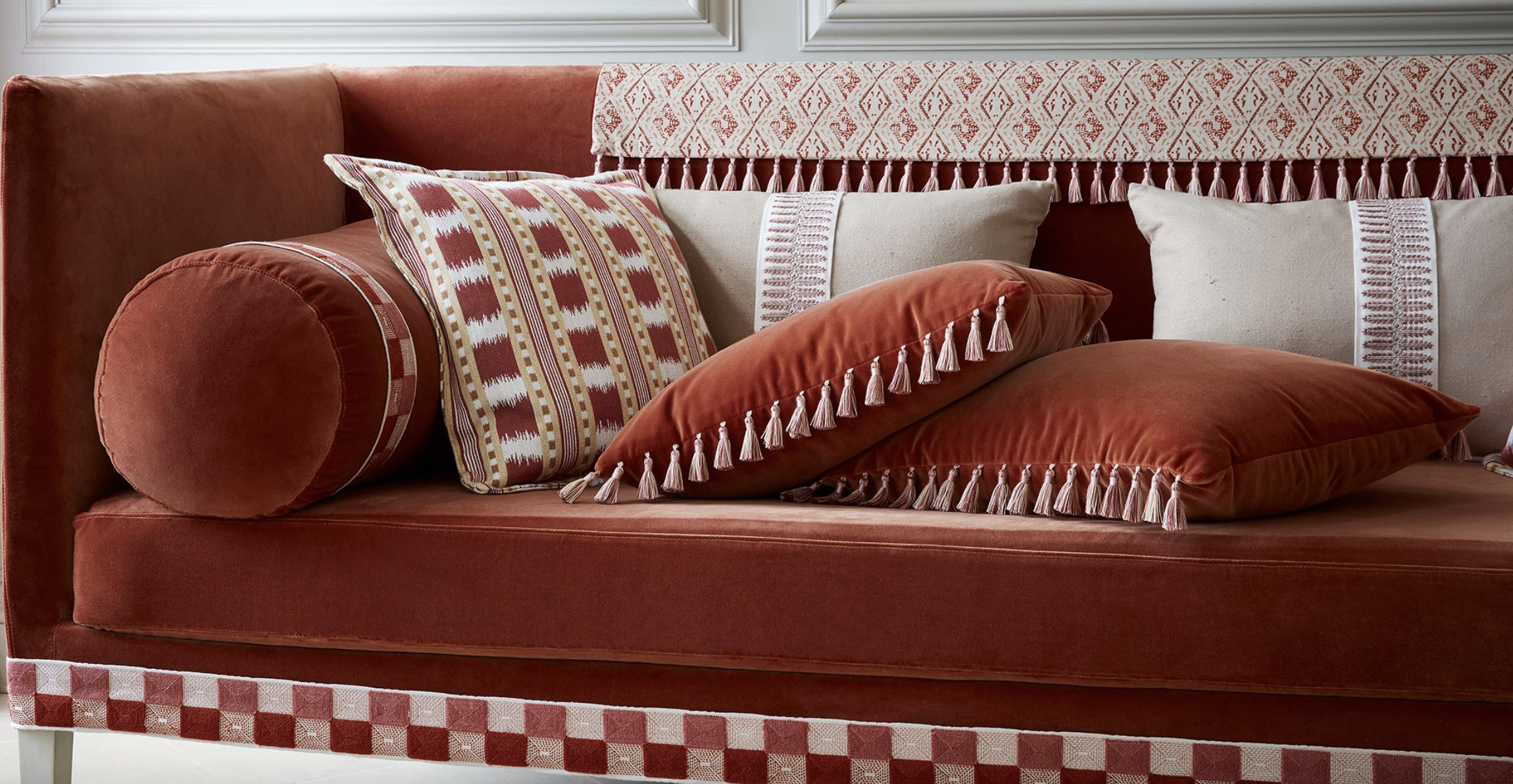PASSEMENTERIE A GUIDE
17th Century Passementerie
Passementerie is the art of creating elaborate trimmings, such as tassels, fringes, braids, cords, galloons (woven bands), and gimps, typically used to decorate textiles, furniture, and clothing. The word comes from the French ‘Passement’, meaning “ornamental edging or trimming.” In interior design, passementerie elevates upholstery, curtains, cushions, and wall coverings, adding refinement and visual richness.
History of Passementerie
Ancient Civilisations (3,000 BCE – 500 CE)
Egypt: Linen cords, fringes, and beadwork adorned garments, ceremonial cloths, and furniture. Fringes were both decorative and symbolic — cut edges of fabric were often knotted into fringes to prevent unraveling. Some of the earliest tassels where found in Egyptian tombs.
Greece & Rome: Decorative borders and cords embellished togas, military cloaks, and home textiles. Roman couches and curtains sometimes featured woven trims, often in contrasting colours.
Early Medieval Period (500–1000 CE)
Decorative cords reinforced the sacred and ceremonial roles of fabrics in churches and royal courts.
High & Late Middle Ages (1000–1500 CE)
Antique tassels
Guilds Established: By the 13th century, European artisans specialising in trimmings formed organised guilds. France and Italy became key centres.
Materials: Silk, gold, and silver threads were common in church vestments and By royalty.
Secular Use Expands: Nobility used passementerie on canopies, bed hangings, and ceremonial garments.
Cottage Industry:Trims were often made by single women, married women needed their husbands permission. They would also make lace and ribbons.
Passementerie became a marker of hierarchy: the more elaborate the trim, the higher the status.
Renaissance (16th Century)
Decorative trimmings flourished alongside innovations in textile weaving.
Passementiers in France and Venice refined tassel-making to an art form.
Huguenots helped to bring the craft to the Uk.
Interiors of palaces began featuring heavy use of tassels, fringes, and cords on curtains, bed drapes, and upholstered furniture.
Passementerie was used not only for embellishment but also to hide construction seams on furniture and fabric panels.
Baroque & Louis XIV’s France (17th Century)
Golden Age of Passementerie: Under Louis XIV, Versailles became the epicentre of opulent decoration. The King supported guilds of passementiers, who gained great prestige.
Tassels (glands) became highly elaborate, often featuring multiple layers of silk, metallic threads, and tiny ornaments called bouillons.
Heavy draperies in state rooms were trimmed with fringes and braids; furniture edges finished with gilded galloons and cords.
Passementerie was so prized it was inventoried separately from furniture in estate records, often more valuable than the textile itself.
Antique passemnterie
18th Century (Rococo & Neoclassicism)
The Rococo style emphasised playful, delicate ornamentation. Passementerie reflected this shift with lighter, more intricate trimmings in pastels and florals.
Neoclassical interiors used simpler galloons and narrow braids with geometric motifs, in keeping with Greco-Roman inspiration.
Passementerie also became fashionable in women’s dress — trims on gowns and accessories mirrored those in interiors.
19th Century (Empire, Victorian, & Revival Styles)
Empire Style (early 1800s): Passementerie became bold and classical, using strong cords, laurel motifs, and tassels in Napoleonic interiors.
Victorian Period (mid–late 1800s): This was a second great age of passementerie. Heavy fringes, bullion tassels, and layered braids adorned:
Curtains with pelmets and swags
Deep-buttoned upholstery with skirts trimmed in fringe
Lampshades with dramatic beaded fringes
Industrialisation allowed mass production, making passementerie accessible beyond the aristocracy. Even middle-class homes had fringed antimacassars, cushion trims, and tasseled draperies.
Modern upholstry trim and tassels
20th Century
Early 1900s (Edwardian & Art Nouveau): Passementerie was lighter and more stylized, often featuring floral and organic motifs.
1920s–30s (Art Deco): Geometric galloons and bold cords reflected modernist aesthetics. Fringe took on a new role in fashion (think flapper dresses), though interiors used it more sparingly.
Mid-20th Century (Modernism): With the rise of minimalist design, passementerie fell out of favour. Designers like Le Corbusier and Mies van der Rohe rejected decorative trims in favour of clean lines.
Late 20th Century: Historicist revivals (French Provincial, English Country House, Hollywood Regency) brought passementerie back in decorative interiors.
21st Century
Selective Use: Today, passementerie is often used sparingly — not as lavish covering, but as accents to highlight craftsmanship. But there is a maxamalist movement in interior design which is bringing back the use of passementerie, to decorate curtains, cushions and on sofas.
Modern Adaptations:
Natural fibres (linen, cotton) instead of silk
Minimalist cords and monochrome braids for contemporary interiors
Tassels and fringes reimagined in playful, oversized, or colourful ways in eclectic and bohemian design
Luxury Interiors: In high-end residential and hospitality projects, passementerie is still a hallmark of custom drapery and upholstery, referencing centuries of tradition.
Antique Tassel
Styles of Passementerie & Their Use
1. Tassels (Glands)
Description: A bundle of threads, silk cords, or metallic strands tied together at one end with a decorative “head” or cap.
Examples:
French Baroque Tassels: Large silk tassels with multiple layers, often paired with metallic bouillons (curled threads).
Victorian Key Tassels: Smaller tassels hung from cabinet or wardrobe keys.
Contemporary Tassels: Oversized cotton or wool tassels used on bohemian cushions or curtain tiebacks.
Drapery Tiebacks: Luxurious tassel tiebacks can transform plain curtains into focal points.
Furniture Keys: Tassels add a romantic or historical feel when tied to armoire or bureau keys.
Cushions & Throws: Small corner tassels add whimsy and movement.
Lighting: Used as finials on lamps or chandelier embellishments in traditional interiors.
Fringed cushions
2. Fringe
Description: A decorative edging of hanging threads, cords, or beads.
Examples:
Bullion Fringe: Long, twisted cords of silk or metallic thread, used heavily in 19th-century parlours.
Brush Fringe: Soft, dense threads cut evenly like a brush, often found on cushions or lampshades.
Beaded Fringe: Glass beads or crystals strung together, popular in Art Deco and Victorian lampshades.
Loop Fringe: Rounded thread loops used on lightweight fabrics or casual trims.
Curtains & Valances: Adds weight and movement to draperies.
Furniture: Applied along sofa bases, ottoman skirts, or armchair edges.
Cushions & Bedding: Adds texture and a tactile finish.
Lighting: Beaded or brush fringe softens lamp edges, creating a vintage glow.
Modern cushions decorated with braid.
3. Braids & Gimps
Description: Narrow woven trims, often geometric, used for edging and concealing raw fabric edges.
Examples:
Gimp Braid: A flat, narrow, slightly raised braid with a scrolling or wavy pattern.
Herringbone or Chevron Braids: Woven bands with zigzag or geometric motifs.
Metallic Galloon Braid: Gold or silver woven band, often used in ceremonial or ecclesiastical textiles.
Upholstery: Covers seams, tacks, or staples along the edges of chairs, sofas, and headboards.
Curtains: Applied to the leading edges of drapery panels as a decorative border.
Accent Decoration: Outlines cushions, lampshades, or wall panels for contrast.
Tailored Finishes: Offers a neat, subtle trim in contemporary interiors where tassels and fringes may feel too ornate
Decorative Ropes
4. Cords & Ropes
Description: Twisted strands of fibres, silk, or metallic threads, often plied in contrasting colors.
Examples:
Silk Ropes: Common in Baroque interiors, often finished with tassel ends.
Two-Tone Twisted Cords: Popular in French Provincial upholstery.
Natural Linen Rope: Contemporary eco-friendly variant, often used in rustic interiors.
Drapery Tiebacks: Rope tiebacks provide a simple or dramatic alternative to hardware.
Piping (Corded Edges): Outlines cushions, bolsters, and bedding.
Furniture Outlines: Adds a dimensional border to armchairs, sofas, and ottomans.
Architectural Detailing: Thick cords or ropes applied as borders around mirrors, doorframes, or paneling.
Antique Metallic Gallion
5. Galloons & RibbonsDescription: Flat, woven bands of silk, cotton, or metallic thread; can be patterned or plain.
Examples:
Gold Galloon: Wide, metallic band used on military uniforms and Baroque furniture.
Velvet Ribbon with Metallic Edge: Popular in Rococo and Victorian interiors.
Modern Graphic Banding: Clean woven bands in solid or geometric colors for a contemporary edge.
Borders on Curtains: Runs vertically along the leading edge or bottom hem.
Wall Coverings: Frames fabric wall panels or wallpaper for a formal effect.
Furniture Trim: Adds a band of contrast along upholstered chairs or benches.
Graphic Accent: Modern designers use galloon-like bands to add bold lines on neutral textiles.
Modern Key Tassel
6. Key Tassels (Smaller Category)
Description: Miniature tassels, functional yet decorative.
Examples:
18th-Century French Key Tassels: Found on armoires and desks in aristocratic homes.
Victorian Desk Tassels: Decorative pulls for drawers and cabinets.
Contemporary Versions: Leather or linen tassels on minimalist furniture.
Cabinetry & Hardware: Adds charm to wardrobes, bureaus, and desks.
Decorative Accessories: Used as ornaments on baskets, door handles, or even books.
Layered Detail: Creates a sense of history and craftsmanship in otherwise simple furniture.
Contemporary upholstery trim used on sofa cushion and curtain
How Each Style is Used Today
Traditional/Classical Interiors: Tassels, bullion fringe, and galloon braids maintain authenticity in period-style homes.
Eclectic & Bohemian Styles: Bold brush fringes, colourful tassels, and beaded trims inject playfulness and texture.
Minimalist/Modern Interiors: Cords, narrow braids, and tonal banding provide clean finishes without overwhelming decoration.
Luxury Hospitality: Passementerie continues to appear in hotels, luxury homes, theatres, and palaces where grandeur and ceremony are emphasised.
Contemporary upholstery used on sofa and cushions












